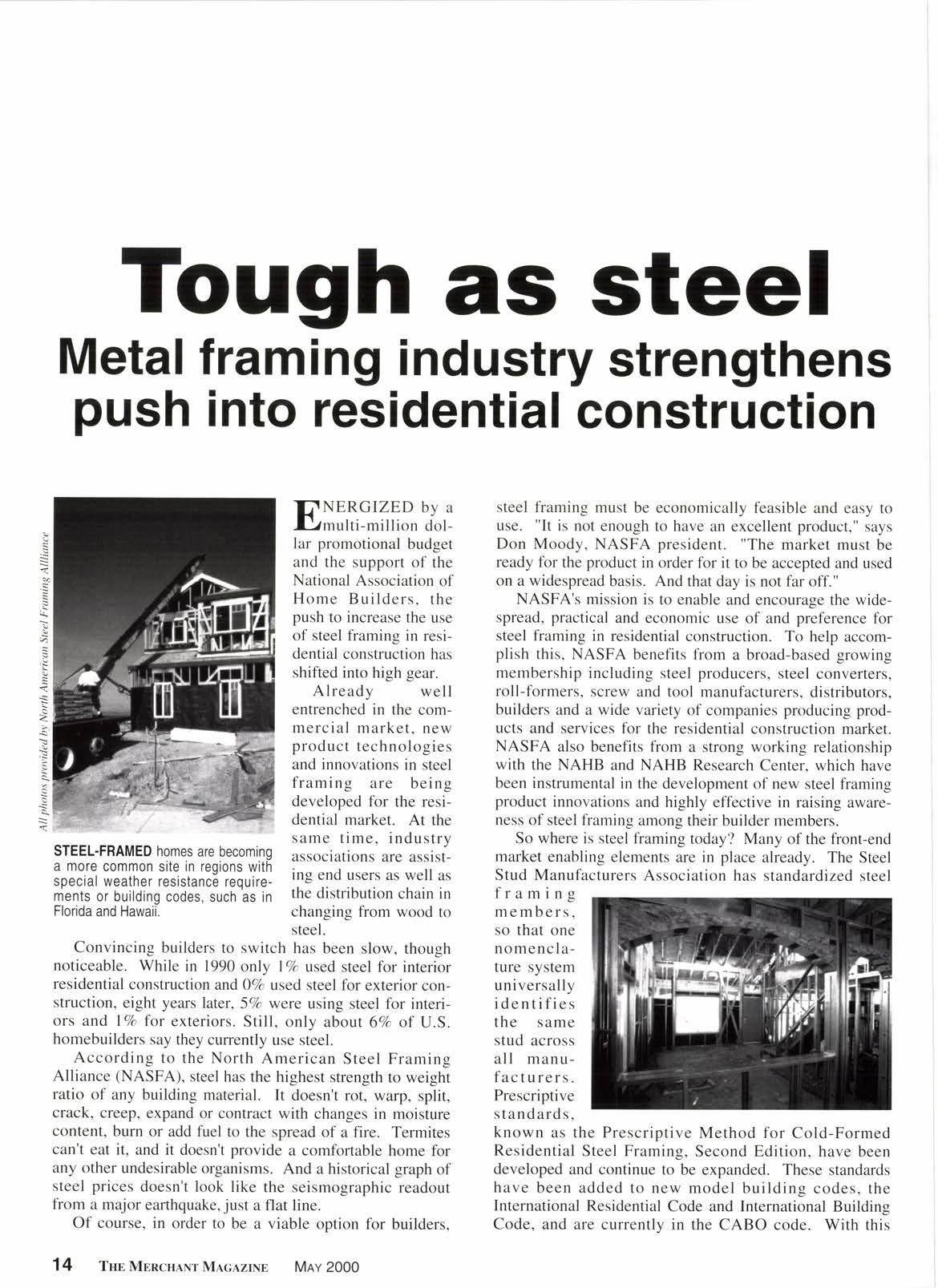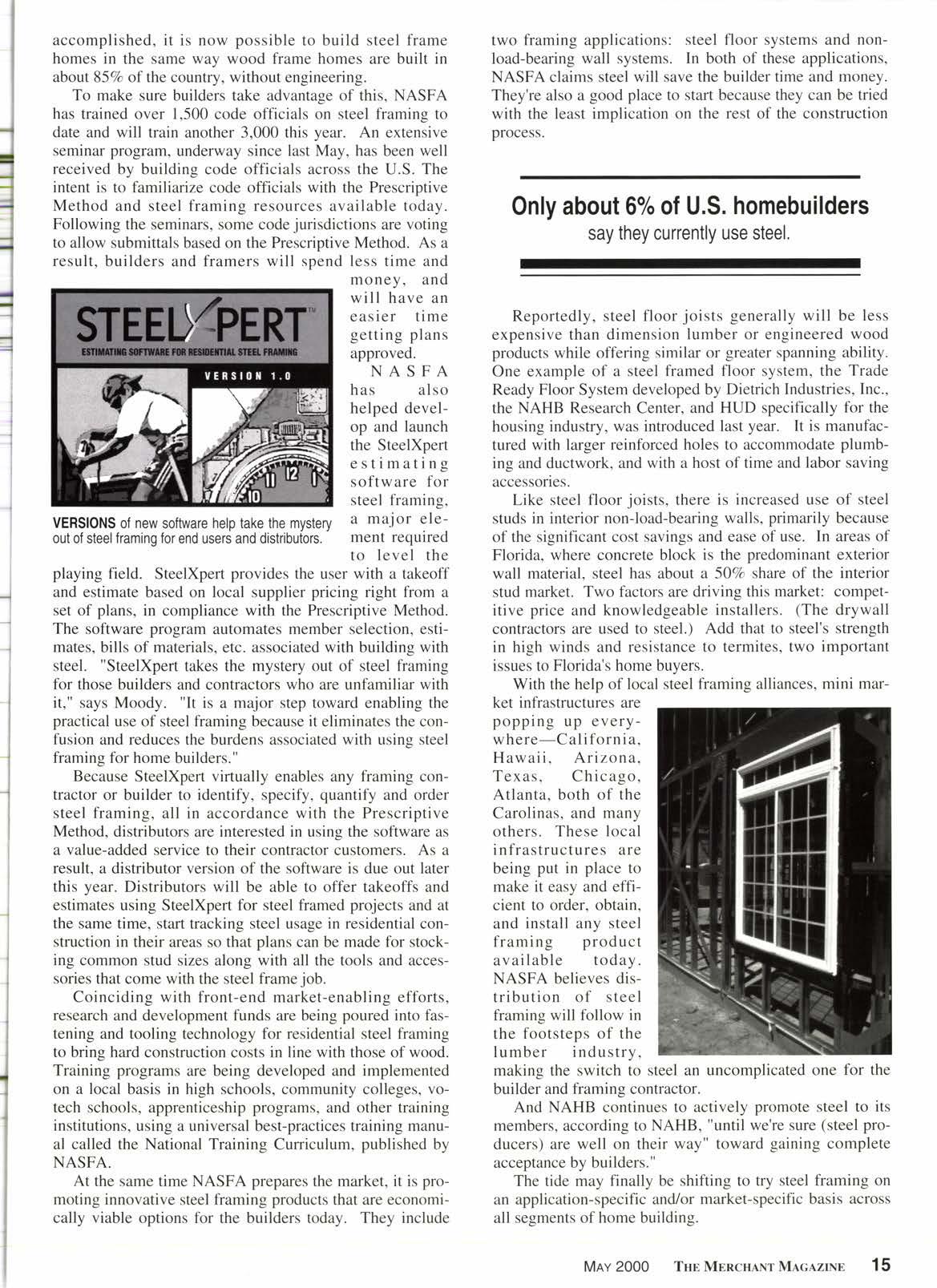
5 minute read
Tough as steel
Metal framing industry strengthens push into residential construction
ETNERGIZED by a -U.rmulti-million dollar promotional budget and the support of the National Association of Home Builders, the push to increase the use of steel framing in residential construction has shifted into high gear.
Already well entrenched in the commercial market, new product technologies and innovations in steel framing are being developed for the residential market. At the same time, industry associations are assisting end users as well as the distribution chain in changing from wood to steel.
Convincing builders to switch has been slow, though noticeable. While in 1990 only l%o used steel for interior residential construction and O7o used steel for exterior construction, eight years later,57o were using steel for interiors and l7o for exteriors. Still, only about 67o of U.S. homebuilders say they currently use steel.
According to the North American Steel Framing Alliance (NASFA), steel has the highest strengrh ro weight ratio of any building material. It doesn't rot, warp, split, crack, creep, expand or contract with changes in moisture content, burn or add fuel to the spread of a fire. Termites can't eat it, and it doesn't provide a comfortable home for any other undesirable organisms. And a historical graph of steel prices doesn't look like the seismographic readout from a major earthquake, just a flat line.
Of course, in order to be a viable option for builders, steel framing must be economically feasible and easy to use. "It is not enough to have an excellent product," says Don Moody, NASFA president. "The market must be ready for the product in order for it to be accepted and used on a widespread basis. And that day is not far off."
NASFA's mission is to enable and encourage the widespread, practical and economic use of and preference for steel framing in residential construction. To help accomplish this, NASFA benefits from a broad-based growing membership including steel producers, steel converters, roll-formers, screw and tool manufacturers, distributors, builders and a wide variety of companies producing products and services for the residential construction market. NASFA also benefits from a strong working relationship with the NAHB and NAHB Research Center, which have been instrumental in the development of new steel framing product innovations and highly effective in raising awareness of steel framing among their builder members.
So where is steel framing today? Many of the front-end market enabling elements are in place already. The Steel Stud Manufacturers Association has standardized steel framing members, so that one nomenclature system universally identifies the same stud across all manufacturers.
Prescriptive standard s, known as the Prescriptive Method for Cold-Formed Residential Steel Framing, Second Edition, have been developed and continue to be expanded. These standards have been added to new model building codes, the International Residential Code and International Building Code, and are currently in the CABO code. With this accomplished, it is now possible to build steel frame homes in the same way wood frame homes are built in about 857o of the country, without engineering.
To make sure builders take advantage of this, NASFA has trained over 1,500 code officials on steel framing to date and will train another 3,000 this year. An extensive seminar program, underway since last May, has been well received by building code officials across the U.S. The intent is to familiarize code officials with the Prescriptive Method and steel framing resources available today. Following the seminars, some code jurisdictions are voting to allow submittals based on the Prescriptive Method. As a result, builders and framers will spend less time and two framing applications: steel floor systems and nonload-bearing wall systems. In both of these applications, NASFA claims steel will save the builder time and money. They're also a good place to start because they can be tried with the least implication on the rest of the construction process.
Only about 6% of U.S. homebuilders say they currently use steel,
NASFA has also helped develop and launch the SteelXpert estimating software for steel framing, a major element required to level the playing field. SteelXpert provides the user with a takeoff and estimate based on local supplier pricing right from a set of plans, in compliance with the Prescriptive Method. The software program automates member selection, estimates, bills of materials, etc. associated with building with steel. "SteelXpert takes the mystery out of steel framing for those builders and contractors who are unfamiliar with it," says Moody. "It is a major step toward enabling the practical use of steel framing because it eliminates the confusion and reduces the burdens associated with using steel framing for home builders."
Because SteelXpert virtually enables any framing contractor or builder to identify, specify, quantify and order steel framing, all in accordance with the Prescriptive Method, distributors are interested in using the software as a value-added service to their contractor customers. As a result, a distributor version of the software is due out later this year. Distributors will be able to offer takeoffs and estimates using SteelXpert for steel framed projects and at the same time, start tracking steel usage in residential construction in their areas so that plans can be made for stocking common stud sizes along with all the tools and accessories that come with the steel frame job.
Coinciding with front-end market-enabling efforts, research and development funds are being poured into fastening and tooling technology for residential steel framing to bring hard construction costs in line with those of wood. Training programs are being developed and implemented on a local basis in high schools, community colleges, votech schools, apprenticeship programs, and other training institutions, using a universal best-practices training manual called the National Training Curriculum, published by NASFA.

At the same time NASFA prepares the market, it is promoting innovative steel framing products that are economically viable options for the builders today. They include
Reportedly, steel floor joists generally will be less expensive than dimension lumber or engineered wood products while offering similar or greater spanning ability. One example of a steel framed floor system, the Trade Ready Floor System developed by Dietrich Industries, Inc., the NAHB Research Center, and HUD specifically for the housing industry, was introduced last year. It is manufactured with larger reinforced holes to accommodate plumbing and ductwork, and with a host of time and labor saving accessories.
Like steel floor joists, there is increased use of steel studs in interior non-load-bearing walls, primarily because of the significant cost savings and ease of use. In areas of Florida, where concrete block is the predominant exterior wall material, steel has about a 507o share of the interior stud market. Two factors are driving this market: competitive price and knowledgeable installers. (The drywall contractors are used to steel.) Add that to steel's strength in high winds and resistance to termites, two important issues to Florida's home buyers.
With the help of local steel framing alliances, mini market infrastructures are popping up everywhere-California.
Hawaii, Arizona, Texas, Chicago, Atlanta, both of the Carolinas, and many others. These local infrastructures are being put in place to make it easy and efficient to order, obtain, and install any steel framing product available today.
NASFA believes distribution of steel framing will follow in the footsteps of the lumber industry, making the switch to steel an uncomplicated one for the builder and framing contractor.
And NAHB continues to actively promote steel to its members, according to NAHB, "until we're sure (steel producers) are well on their way" toward gaining complete acceptance by builders."
The tide may finally be shifting to try steel framing on an application-specific and/or market-specific basis across all seements of home buildins.










